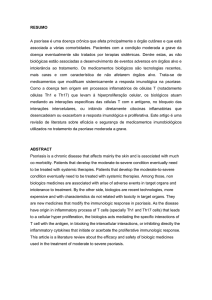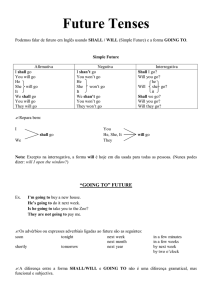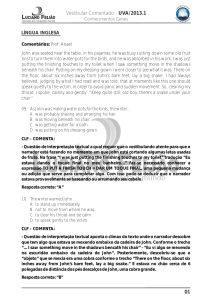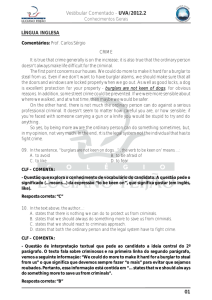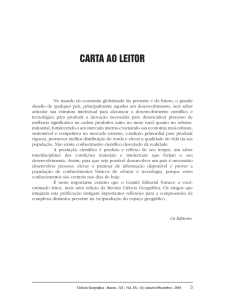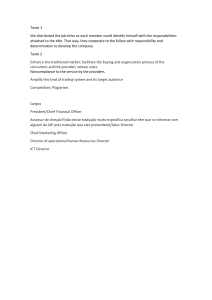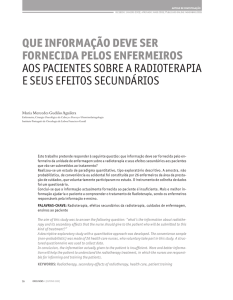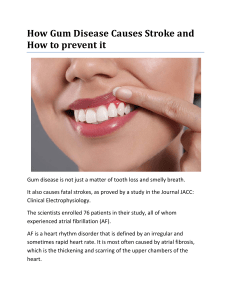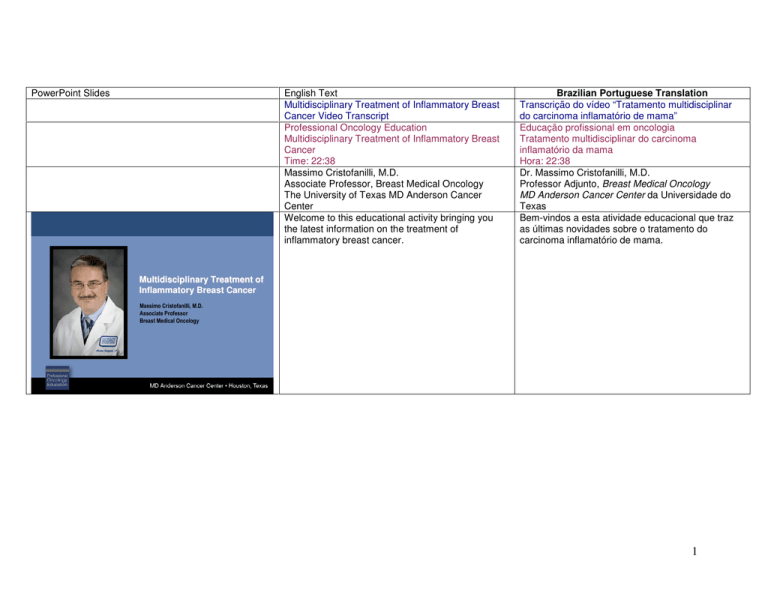
PowerPoint Slides
Multidisciplinary Treatment of
Inflammatory Breast Cancer
English Text
Multidisciplinary Treatment of Inflammatory Breast
Cancer Video Transcript
Professional Oncology Education
Multidisciplinary Treatment of Inflammatory Breast
Cancer
Time: 22:38
Massimo Cristofanilli, M.D.
Associate Professor, Breast Medical Oncology
The University of Texas MD Anderson Cancer
Center
Welcome to this educational activity bringing you
the latest information on the treatment of
inflammatory breast cancer.
Brazilian Portuguese Translation
Transcrição do vídeo “Tratamento multidisciplinar
do carcinoma inflamatório de mama”
Educação profissional em oncologia
Tratamento multidisciplinar do carcinoma
inflamatório da mama
Hora: 22:38
Dr. Massimo Cristofanilli, M.D.
Professor Adjunto, Breast Medical Oncology
MD Anderson Cancer Center da Universidade do
Texas
Bem-vindos a esta atividade educacional que traz
as últimas novidades sobre o tratamento do
carcinoma inflamatório de mama.
Multidisciplinary Treatment of
Inflammatory Breast Cancer
Massimo Cristofanilli, M.D.
Associate Professor
Breast Medical Oncology
1
Multidisciplinary Treatment of
Inflammatory Breast Cancer
Today, we will focus on the update in the
multidisciplinary treatment of this disease.
Hoje nos concentraremos na atualização do
tratamento multidisciplinar do carcinoma
inflamatório de mama.
Inflammatory breast cancer is a locally advanced
inoperable disease at the time of presentation. It
presents, actually, in 30 percent of the cases, with
metastatic disease already. So it is important that a
multidisciplinary approach be part of the treatment
of this disease, particularly induction chemotherapy,
or systemic therapy, followed by mastectomy, in the
case where the disease is responding properly, and
chest wall irradiation. This represents the standard
of care for inflammatory breast cancer. The
pathological response to the induction
chemotherapy is definitely the most important
prognostic factor identified so far. Unfortunately,
only 10 to 15 percent of these patients achieved a
complete pathological response. Anthracycline and
taxane-based regimens had been in the past,
traditionally used to treat inflammatory breast
cancer in patients, and had been shown to be the
most effective of these treatments.
O carcinoma inflamatório de mama é uma doença
inoperável localmente avançada no momento da
apresentação. Na verdade, em 30% dos casos já se
apresenta como doença metastática. Então, é
importante que uma abordagem multidisciplinar
faça parte do tratamento desta doença,
especialmente, a quimioterapia de indução ou a
terapia sistêmica procedida por mastectomia,
quando a doença responda adequadamente, e a
irradiação da parede torácica. Isto representa o
tratamento padrão para o carcinoma inflamatório de
mama. A resposta patológica à quimioterapia de
indução é, sem dúvida, o fator prognóstico mais
importante identificado até agora. Infelizmente, só
uma faixa de 10% a 15% destas pacientes alcançou
uma resposta patológica completa. Os esquemas
terapêuticos com antraciclina e taxanos têm sido
utilizados para tratar pacientes com carcinoma
inflamatório de mama e provaram ser os mais
eficazes destes tratamentos.
Update on the Multidisciplinary Treatment
Multidisciplinary Treatment of
Inflammatory Breast Cancer
The Multidisciplinary Management of IBC
• Induction chemotherapy (IC) followed by
mastectomy and chest wall irradiation represents
the standard of care for IBC
• Pathological response to IC represents the most
important prognostic factor
• Anthracyclines and taxane-based regimens are
traditionally used as IC in IBC
Fleming RY et al. Ann Surg Oncol 1997 4(6):452
2
Multidisciplinary Treatment of
Inflammatory Breast Cancer
The MDA Experience with Anthracyclines-based
Regimens (1974-92)
Cristofanilli M et al. Cancer 2001 92(7):1775
The MD Anderson Cancer Center has a large
experience in treating inflammatory breast cancer
over the last 30 years. And periodically, we had
inflammatory breast cancer-dedicated protocols
where the several different regimens were tested.
Initially, they were mostly based on anthracycline
regimens, three drugs together. And the various
modalities were combined using sequence.
Approximately 178 patients were treated with
inflammatory breast cancer protocols dedicated
between 1974 and 1992. The first protocol actually
was extremely interesting but they did not include
surgery only radiation therapy after completion of
induction chemotherapy. So we used only clinical
response and overall survival and progression-free
survival to compare with the others. All the others
included mastectomy after completion of induction
chemotherapy. While this concept seems to be easy
and established at this point, at that time, it was
quite revolutionary.
O MD Anderson Cancer Center possui ampla
experiência acumulada ao longo dos últimos 30
anos no tratamento do carcinoma inflamatório de
mama. E, periodicamente, temos tido protocolos
exclusivamente dedicados ao carcinoma
inflamatório de mama em que foram testados
diversos esquemas terapêuticos. No início, eles se
baseavam principalmente em esquemas com
antraciclina, três fármacos juntos. E as várias
modalidades foram combinadas sequencialmente.
Aproximadamente 178 pacientes foram tratadas
segundo os protocolos para o carcinoma
inflamatório de mama dedicados entre 1974 e 1992.
Na realidade, o primeiro protocolo foi extremamente
interessante, mas não incluíram cirurgia, somente
radioterapia após o término da quimioterapia de
indução. Então, utilizámos somente a resposta
clínica e a sobrevida global e a sobrevida sem
progressão para compará-las com outras. Todas as
outras incluíram a mastectomia após o término da
quimioterapia de indução. Embora neste momento
esta noção pareça ser fácil e estabelecida, naquela
época foi bastante revolucionária.
3
Multidisciplinary Treatment of
Inflammatory Breast Cancer
Efficacy of DoxorubicinDoxorubicin-based Regimens in IBC
Cristofanilli M et al. Cancer 2001 92(7):1775
Multidisciplinary Treatment of
Inflammatory Breast Cancer
Paclitaxel in IBC Benefit in ERER-neg Disease
When the different kinds of protocols were
compared in the various combinations, for example,
one of the important aspects of this evaluation was
that pathological CR and clinical CR did not agree
many times; suggesting that the clinical evaluation,
even done [by a] multidisciplinary experienced
team, was not always mirroring what the reality of
the disease was. In particular, the presence of nonpalpable mass makes [it] quite difficult to assess the
response in the disease. The clinical CR was
present in approximately 12 percent of the cases.
While the pathological CR was around that, but did
not match many times what the clinical assessment
was. So this was part of the finding important, that
brought us to use more and more imaging in
assessing and following these patients who used
induction chemotherapy.
When the anthracyclines were the backbone of this
disease, we were obviously achieving a limit of--in
the terms of pathological CR prognosis.
Subsequently, the taxanes were introduced,
particularly Paclitaxel. And [it] appeared that
particularly for the patients that were triple negative
or had negative disease, this resulted in a benefit, at
least in the short term, in terms of progression-free
survival and overall survival; suggesting this also
should have been an important component of the
induction chemotherapy of these patients.
Quando foram comparadas diferentes combinações
dos vários tipos de protocolos, por exemplo, um dos
aspectos importantes desta avaliação foi que,
muitas vezes, não houve concordância entre a
resposta patológica completa e a resposta clínica
completa, sugerindo que a avaliação clínica,
mesmo sendo realizada [por uma] equipe
multidisciplinar experiente, nem sempre refletia a
realidade da doença. Especialmente, a presença de
massas não-palpáveis dificulta a avaliação da
resposta na doença. A resposta clínica completa
estava presente em aproximadamente 12% dos
casos. E embora a resposta patológica completa
fosse em torno disso, na maioria das vezes, não
concordou com a avaliação clínica. Então, isto foi
parte do achado [que foi] importante [porque] nos
levou a utilizar cada vez mais a imagiologia para
avaliar e dar acompanhamento a estas pacientes
submetidas à quimioterapia de indução.
Quando as antraciclinas constituíram a espinha
dorsal desta doença, obviamente, atingíamos o
limite de – em termos de prognóstico da resposta
patológica completa. Subsequentemente, os
taxanos foram introduzidos, especialmente o
Paclitaxel. E pareceu que especialmente para estas
pacientes com [câncer] triplo negativo ou negativo
para esta doença, isto resultou em benefício, pelo
menos a curto prazo, em termos de sobrevida sem
progressão e sobrevida global, sugerindo que isto
também poderia ter sido um componente
importante da quimioterapia de indução nestas
pacientes.
Cristofanilli M et al. Clin Breast Cancer 2004 4(6):415
4
Multidisciplinary Treatment of
Inflammatory Breast Cancer
IBC OS by Decade of Diagnosis
Gonzalez-Angulo AM et al. Oncologist 2007 12(8):904
Multidisciplinary Treatment of
Inflammatory Breast Cancer
XRT and Locoregional Control
Local-Regional Control
Response to Neoadjuvant Chemotherapy
Local-Regional Control
No Response to Neoadjuvant Chemotherapy
Bristol IJ et al. Int J Radiat Oncol Bio Phys 72(2):474
Over time, we have also been able to compare what
has been the impact of our treatments on patients
over the various different decades. What was
noticed [was] that obviously these patients benefited
by the introduction of systemic chemotherapy
compared to the local therapy. And this is what
happened between the '80's--'70's and the '80's.
Subsequently a different type of chemotherapy
regimen, that I already showed you, that didn't seem
to be having a long-term effect or benefit for these
patients; suggesting probably, that there is part of
this treatment that is not appropriate with these
patients. Or most likely, they need additional
therapy that doesn't necessarily affect [only] the
proliferation of the tumor but also the metastatic
process of this tumor. In that sense, other therapies
are being looked at.
The importance of local-regional therapy has also
come out of doing this experience, in particular, the
role of intensified radiation therapy, twice a day,
hyperfractionated, 66 Gray. And MD Anderson
championed this particular treatment. And you can
see that the local-regional control is quite good and
[it] is particularly important for patients to achieve a
response to neo-adjuvant therapy. But also not
response to neo-adjuvant therapy is supposed to
achieve some local control that is significant, even
though the systemic disease actually doesn't follow
the same pattern. So this is actually important now,
in perspective, because there are patients that do
not respond to induction chemotherapy in which we
can maximize the local control - maybe in [a] future
combination therapy with chemotherapy, other
agents of radiation, and the possibility of bringing to
surgery even in cases that don't respond to
Com o decorrer do tempo, também pudemos
comparar qual foi o impacto de nossos tratamentos
nas pacientes ao longo das décadas. O que foi
observado [foi] que, obviamente, estas pacientes se
beneficiaram com a introdução da quimioterapia
sistêmica em relação à terapia local. E isso foi o
que aconteceu entre as décadas de 1980 e 1970 e
na década de 1980. Subsequentemente, surgiu um
tipo diferente de esquema quimioterápico, que eu já
lhes mostrei, que não parecia estar tendo um efeito
de longo prazo ou benefício para estas pacientes,
sugerindo, provavelmente, que há uma parte deste
tratamento que não é adequada para estas
pacientes. Ou, mais provavelmente, elas precisam
de uma terapia suplementar que não
necessariamente afete [somente] a proliferação do
tumor, mas também o processo metastático deste
tumor. Nesse sentido, outras terapias estão sendo
pesquisadas.
A importância da terapia regional e local também
fez parte desta experiência, especialmente, o papel
da radioterapia intensificada, duas vezes por dia,
hiperfracionada, 66 Gray. E o MD Anderson
defendeu especialmente este tratamento. E vocês
podem ver que o controle local e regional é
bastante bom e é especialmente importante para as
pacientes alcançarem uma resposta à terapia
neoadjuvante. Mas, a ausência de resposta à
terapia neoadjuvante também deve alcançar algum
controle local significativo, embora a doença
sistêmica não siga o mesmo padrão. Então, na
verdade, isto é importante agora, em perspectiva,
porque há pacientes que não respondem à
quimioterapia de indução na qual podemos
maximizar o controle local – talvez com [uma] futura
terapia de combinação com quimioterapia, outros
agentes de radiação e a possibilidade de trazer à
5
standard chemotherapy.
Multidisciplinary Treatment of
Inflammatory Breast Cancer
The experience in the past 20 years has been also
reviewed in the community base. The British
Columbia experience has seen that going from an
approach where the different specialists did not
work together to a multidisciplinary approach, per
se, has improved the overall local-regional control of
the disease.
cirurgia até os casos que não respondem à
quimioterapia padrão.
A experiência nos últimos 20 anos também tem sido
analisada na comunidade. No caso da Colúmbia
Britânica, eles observaram que passar de uma
abordagem em que os diversos especialistas não
trabalhavam juntos para outra, multidisciplinar, per
se, melhorou o controle local e regional global da
doença.
And this is because of the use of better
chemotherapy, the CEF, ATPT and the Quartet is
one of the regimens used in this particular
community. It appeared to be affecting the localregional control, as well as systemic therapy control;
suggesting that chemotherapy is also important for
local control.
E isto se deve ao uso de uma melhor quimioterapia,
o CEF, ATPT e o Quartet são uns dos esquemas
utilizados nesta comunidade e parecia estar
afetando o controle local e regional, bem como o
controle da terapia sistêmica, sugerindo que a
quimioterapia também é importante para o controle
local.
Panades M et al. J Clin Oncol 2005 23(9):1941
Multidisciplinary Treatment of
Inflammatory Breast Cancer
Panades M et al. J Clin Oncol 2005 23(9):1941
6
Multidisciplinary Treatment of
Inflammatory Breast Cancer
One of the most important questions that was
addressed also for the study, [is] the use of
mastectomy or surgery, primary surgery, in the
context of this multidisciplinary approach. You see
that mastectomy, before or after local-regional-systemic therapy and radiation therapy, is much
better, more important for local-regional control as
expected, compared to no mastectomy at all. This
may have also some effect on systemic disease.
Once again, highlighting the fact that several
interventions in a multidisciplinary approach is
extremely important to better control, local and
distant.
Uma das perguntas mais importantes que também
foi formulada pelo estudo é o uso de mastectomia
ou cirurgia, cirurgia primária, no contexto desta
abordagem multidisciplinar. Vocês veem que a
mastectomia, antes ou depois da terapia sistêmica
local e regional e da radioterapia, é muito melhor,
mais importante para o controle local e regional do
que o esperado, do que não fazer mastectomia. Isto
também pode ter certo efeito na doença sistêmica.
Novamente, salientando o fato de que diversas
intervenções em uma abordagem multidisciplinar é
extremamente importante para um melhor controle
local e distante.
The increased biological understanding of this
disease has brought us the possibility of using
several targeted agents particularly in the
EGFR/Her2 pathway, but also angiogenesis has
been a focus of research in the last few years.
O maior conhecimento biológico desta doença nos
permitiu a possibilidade de utilizar vários agentes
dirigidos, especialmente na via do EGFR/Her2,
mas, a angiogênese também tem sido objeto de
pesquisa nos últimos anos.
Panades M et al. J Clin Oncol 2005 23(9):1941
Multidisciplinary Treatment of
Inflammatory Breast Cancer
Inflammatory Breast Cancer Molecular Targets
Adapted from Yamauchi H et al. Nat Rev Clin Oncol 2009 6(7):387
7
Multidisciplinary Treatment of
Inflammatory Breast Cancer
Current Therapeutic Approaches for
Inflammatory Breast Cancer
• Targeted therapies in IBC
- Growth factor receptors – EGFR, Her-2
- Antiangiogenesis
- Identification and validation of novel
therapeutic agents
Multidisciplinary Treatment of
Inflammatory Breast Cancer
Prognosis and HER-2 Status
Dawood S et al. Cancer 2008 112(9):1905
So the current therapeutic approach for
inflammatory breast cancer takes into account this
knowledge, in particular, the targeted therapy in IBC
for growth factor receptor over- expression,
amplification for EGFR, Her2, and angiogenesis. At
the same time there is a possibility now to identify
with several models and validate novel therapeutic
targets. And this is an ongoing process and I will
speak briefly about that.
Então, a abordagem terapêutica atual para o
carcinoma inflamatório de mama leva em conta este
conhecimento, em especial, a terapia dirigida no
CIM no que respeita à sobre-expressão dos
receptores do fator de crescimento, à amplificação
do EGFR, Her2 e à angiogênese. Ao mesmo
tempo, agora existe a possibilidade de identificar,
com vários modelos, e validar novos alvos
terapêuticos. E este é um processo contínuo e
falarei rapidamente sobre isso.
First of all, the prognosis and the expression of Her2
and EGFR. The Her2 status has been seen in
retrospective as a prognostic factor that has been
investigated. These are patients that were never
exposed to Herceptin during the treatment, the
initial treatment, derived from the protocols and
clinical side I already mentioned. So patients with
Her2-positive disease did not have [a] necessarily
worse prognosis. But they had [an] improved
prognosis the moment they had the recurrence,
because in the metastatic setting, they started to be
exposed to the combination of chemotherapy and
Trastuzumab. And that, as we know, also for noninflammatory breast cancer, has [a] major impact on
the prognosis.
Em primeiro lugar, o prognóstico e a expressão do
Her2 e do EGFR. O status do Her2 tem sido
considerado, em retrospecto, como um fator
prognóstico que tem de ser pesquisado. Estas são
pacientes que nunca foram expostas a Herceptina
durante o tratamento, o tratamento inicial, derivado
dos protocolos e no slide da clínica que já
mencionei. Então, as pacientes com doença
positiva para o Her2 não tiveram necessariamente
[um] pior prognóstico. Mas, elas tiveram [um]
melhor prognóstico no momento em que tiveram a
recorrência porque no ambiente metastático, elas
começaram a ficar expostas à combinação de
quimioterapia e Trastuzumabe.E isso, como
sabemos, também para o carcinoma nãoinflamatório de mama, surte [um] importante
impacto no prognóstico.
8
Multidisciplinary Treatment of
Inflammatory Breast Cancer
NOAH: The Largest Neoadjuvant Trial in HER2Positive Breast Cancer
So the logical consequence was to use a
Herceptin-based regimen in the neoadjuvant
setting. The NOAH trial is a European trial that
represents the largest neo-adjuvant trial performed
in Her2/neu- positive locally advanced breast cancer
including inflammatory breast cancer. Different
chemotherapy regimens than we use, but similar
type of drugs, particularly the ATT and the CMF,
were used in this particular study, where patients
with Her2-positive disease, locally advanced breast
cancer, where exposed to chemotherapy plus or
minus Herceptin.
Então, a consequência lógica foi utilizar um
esquema com base em Herceptina no contexto
neoadjuvante. O NOAH é um estudo europeu que
representa o maior estudo [com terapia]
neoadjuvante realizado em câncer de mama
localmente avançado, positivo para Her2/neu, que
inclui o carcinoma inflamatório de mama. Os
esquemas quimioterápicos utilizados foram
diferentes daqueles que nós utilizámos, mas com
tipos similares de fármacos, especialmente, o ATT
e o CMF foram utilizados especificamente neste
estudo em que as pacientes apresentavam câncer
de mama localmente avançado, positivo para Her2,
e [que] foram expostas à quimioterapia com ou sem
Herceptina.
There was a large population of the inflammatory
breast cancer, and these particular tumors were
mostly the ER/PR-negative as you can see from this
particular slide, and were somewhat aggressive
features of extensive intranodal disease.
A população com carcinoma inflamatório de mama
era grande e a maioria dos tumores eram negativos
para RE/RP, como vocês podem ver neste slide, e
tinham características bastante agressivas de
doença infranodal extensa.
Baselga J et al. ESMO Meeting 2008
Multidisciplinary Treatment of
Inflammatory Breast Cancer
Patient Characteristics
Characteristic
HER2-positive IBC, %
+H
-H
Total pop. IBC pop. Total pop. IBC pop.
(n=115)
(n=31)
(n=113)
(n=31)
Age group
46
<50 years
54
>50 years
Menopausal status
Pre
52
Post
48
Hormonal receptors
ER+ and/or PgR+
35
Both negative
65
Axillary nodes
N0
13
N1
44
N2
43
Ipsilateral supraclavicular nodes
No
94
Yes
6
HER2-negative IBC, %
Total pop.
(n=99)
IBC pop.
(n=14)
32
68
42
58
55
45
51
49
43
57
55
45
50
50
42
58
55
45
50
50
16
84
35
65
23
77
64
36
64
36
19
55
26
16
47
37
26
52
23
17
38
44
29
50
21
90
10
96
4
100
0
96
4
100
0
ER, oestrogen receptor; PgR, progesterone receptor
Baselga J et al. ESMO Meeting 2008
9
Multidisciplinary Treatment of
Inflammatory Breast Cancer
Significant Improvement of pCR in IBC by
Adding Trastuzumab
There was a significant improvement in pCR. The
pCR was defined as eradication of invasive breast
cancer in the breast. When there was a total pCR
evaluated, eradication of invasive cancer in the
breast and the lymph node. Also there was a
statistically significant difference, suggesting that
the addition of Herceptin contributes to improved
local [and] systemic control of this disease. There
are no long-term follow-up studies at this point in
order to be able to evaluate what the prognosis of
this patient would be, but [it] is expected that similar
impact will be seen in systemic disease.
Houve uma diferença significativa na resposta
patológica completa (pCR). A pCR foi definida como
a erradicação do câncer invasivo da mama quando
havia uma total avaliação da pCR [e a] erradicação
do câncer invasivo da mama e do linfonodo. Além
disso, houve uma diferença estatisticamente
significativa, sugerindo que a adição de Herceptina
contribui para o melhor controle local [e] sistêmico
desta doença. Até o momento, não há estudos de
acompanhamento de longo prazo para poder
avaliar o possível prognóstico desta paciente, mas,
espera-se ver um impacto semelhante na doença
sistêmica.
But after this presentation we wanted to understand
if long-term follow-up, actually was associated with
a particular different type of recurrent disease in
these particular patients. We reviewed our
retrospectively treated patients, specifically, 16
newly diagnosed treatment-naive patients with
inflammatory breast cancer. They were also
metastatic in a few cases. They were treated with
various combinations of regimens, particularly to
FEC-Paclitaxel, TCH and Trastuzumab,
administrated prior to surgery. We had a high
pathological CR in these patients, 62.5 percent. Two
of them had stage 4. But because of the excellent
response at presentation they achieved a pCR and
they went to surgery because the surgeon was
convinced that it would have an impact on their
survival.
Mas, depois desta apresentação, é nossa intenção
entender se, na realidade, o acompanhamento de
longo prazo estava associado a um tipo específico
da doença recorrente nestas pacientes.
Examinámos as pacientes tratadas,
especificamente, 16 pacientes recémdiagnosticadas, virgens de tratamento, acometidas
de carcinoma inflamatório de mama. Em alguns
casos elas também apresentavam metástase.
Foram tratadas com vários esquemas de
combinação, especialmente com FEC-Paclitaxel,
TCH e Trastuzumabe, administrados antes da
cirurgia. Vimos uma elevada resposta patológica
completa nestas pacientes, 62,5%. Duas delas
estavam em estádio 4, mas, por causa da excelente
resposta na apresentação, elas alcançaram a pCR
e foram operadas porque o cirurgião se convenceu
do impacto da operação na sobrevida.
Baselga J et al. ESMO Meeting 2008
Multidisciplinary Treatment of
Inflammatory Breast Cancer
Trastuzumab in Primary Inflammatory Breast Cancer
(IBC): Pathological Response Rates and Outcome
• 16 newly diagnosed, treatment-naïve patients
• Pre-operative Trastuzumab and chemotherapy
(FEC-Paclitaxel, TCH) were administered for 20
weeks
• Ten patients (62.5%, 95% CI 35.4% - 84.8%), of
whom two had stage IV disease at presentation,
achieved a pCR
Dawood S et al. Breast J 2010 July 6
10
Multidisciplinary Treatment of
Inflammatory Breast Cancer
Trastuzumab in Primary Inflammatory Breast Cancer
(IBC): Pathological Response Rates and Outcome
• Median follow-up was
24.2 months (range 6.4 –
61.6 months)
• Four (25%) patients
have experienced a
progression, of which
three were in the brain
• Two-year PFS was 59.4%
(95% CI 35% - 100%)
Dawood S et al. Breast J 2010 July 6
Multidisciplinary Treatment of
Inflammatory Breast Cancer
Lapatinib Mechanism of Action
•
Binds to intracellular ATP binding site
of EGFR (ErbB-1) and HER2 (ErbB2) preventing phosphorylation and
activation
•
Blocks downstream signaling through
homodimers and heterodimers of
EGFR (ErbB-1) and HER2 (ErbB-2)
•
Dual blockade of signaling
1+1
2+2
1+2
There was a major follow-up that was longer. The
original study was presented in the NOAH trial, 24.2
months. And interestingly enough, there was
already evidence of progression with these patients.
Three of them were in the brain. So, now it appears
to be that this patient population has a quite
different path of recurrence, where the chest wall
recurrence status that is typical for inflammatory
breast cancer does not appear [to be] the major
driver of recurrence in these particular patients, but
the disease appeared to be in the brain. So this
would probably indicate that we have to develop
other additional strategies, not only to monitor these
patients, but also to address the possibility of
crossing the brain barrier and fight a disease that is
otherwise untreatable for these patients.
So, one of such drugs that is able to cross the brain
barrier is actually the Lapatinib. There are some
advantages in using Lapatinib in inflammatory
breast cancer. First of all [is] the possibility to affect
the EGFR and Her2 and the phosphorylation site,
and so affecting the cascaded events related to the
activation of this signal, and also the possibility of
crossing the brain barrier and eventually prevent or
treat brain metastasis for these patients.
Houve um acompanhamento importante, mais
prolongado. O estudo original foi apresentado no
estudo NOAH, 24,2 meses. O interessante é que já
havia evidência de progressão nestas pacientes.
Três delas, no cérebro. Então, agora parece que
esta população de pacientes apresenta uma via
bastante diferente de recorrência, em que o status
de recorrência na parede torácica, que é comum no
carcinoma inflamatório de mama, não parece [ser] o
principal fator de recorrência nestas pacientes, mas
a doença parece alojar-se no cérebro. Então, isto
poderia indicar que temos que desenvolver outras
estratégias, não somente para monitorar estas
pacientes, mas também para abordar a
possibilidade de atravessar a barreira [hemato]encefálica e lutar contra uma doença que não seria
tratável nestas pacientes.
Um desses fármacos que pode atravessar a
barreira hemato-encefálica é o Lapatinibe. Existem
algumas vantagens em utilizar o Lapatinibe no
carcinoma inflamatório de mama. Em primeiro
lugar, [há] a possibilidade de afetar o EGFR e o
Her2 e o local de fosforilação, afetando, portanto, a
cascata de eventos relacionados à ativação deste
sinal e, também, a possibilidade de atravessar a
barreira hemato-encefálica e, finalmente, prevenir
ou tratar a metástase cerebral destas pacientes.
Downstream signaling cascade
Geyer CE, ASCO 2006
Konecny GE et al. Cancer Res 2006 66(3):1630
Rusnak DW et al. Mol Cancer Ther 2001 1(2):85
Xia W et al. Oncogene 2002 21(41):6255
11
Multidisciplinary Treatment of
Inflammatory Breast Cancer
Johnston S et al. J Clin Oncol 2008 26(7):1066
Lapatinib has been found to be active in
inflammatory breast cancer even in the Phase 1
Trial and, subsequently, a large Phase 2 Trial was
performed. This study was looking at the two
populations, two different strata. One was Cohort A
where the patient had Her2/neu amplification
without EGFR over- expression, and the [other],
Cohort B where EGFR over-expression was
present, Her2/neu was not amplified or overexpressed. The study had also the intention to
differentiate if the mechanism of action, important
for driving the response, particularly in inflammatory,
was EGFR or Her2. And what was found out is
actually the Her2 over-expression or amplification is
driving the response. The patients that had a
significant benefit where only the ones that had
Her2-positive disease. And in fact, you can see in
this particular slide, that this patient with chest wall
recurrence had an almost complete disappearance
of the chest wall disease in [a] matter of [a] few
weeks.
O Lapatinibe mostrou ser ativo no carcinoma
inflamatório de mama no estudo de fase I e,
subsequentemente, foi realizado um grande estudo
de fase II. Neste estudo foram pesquisadas duas
populações, dois estratos diferentes. Um foi a
Coorte A, em que a paciente tinha uma
amplificação no Her2/neu sem sobre-expressão do
EGFR; e o [outro], a Coorte B, em que a sobreexpressão do EGFR estava presente, mas sem
amplificação nem sobre-expressão do Her2/neu. O
estudo também mostrou a intenção de diferenciar
se o mecanismo de ação, importante para estimular
a resposta, especialmente a inflamatória, [estava
associado] ao EGFR ou ao Her2. E o que se
descobriu foi que, na realidade, a sobre-expressão
ou a amplificação do Her2 é o que estimula a
resposta. As pacientes que tiveram um benefício
significativo foram somente aquelas com doença
positiva para o Her2. De fato, vocês podem ver
neste slide que esta paciente com recorrência na
parede torácica, a doença nesta região
desapareceu quase completamente em poucas
semanas.
12
Multidisciplinary Treatment of
Inflammatory Breast Cancer
Lapatinib in Metastatic IBC
The study was also extended and a larger number
of patients were included. This type was only in the
Her2 population. It was clear that the response was
really significant with these patients. These were
patients that were treated heavily, previously with [a]
combination of chemotherapy and Herceptin, up to
six combinations previously, and they had a
significant benefit as a single agent to Lapatinib. So,
representing important factors and important
information, this is the only single agent therapy that
has been found to be effective in inflammatory
breast cancer, only in the Her2/neu population. And
this will be a significant advancement in the
management of these patients.
O estudo foi ampliado e mais pacientes foram
incluídas. Este tipo somente ocorreu na população
Her2. Era evidente que a resposta foi
verdadeiramente significativa nessas pacientes.
Estas eram pacientes que receberam tratamento
intensivo, previamente com [uma] combinação de
quimioterapia e Herceptina, até seis combinações
anteriores, e tiveram um benefício significativo com
o Lapatinibe como único agente. Então,
representando fatores importantes e informações
importantes, esta é a única terapia de um único
agente comprovadamente eficaz no carcinoma
inflamatório de mama somente na população
Her2/neu. E isto será um avanço significativo no
tratamento destas pacientes.
To be able to affect-- the angiogenesis is also an
important factor. As mentioned, there are different
receptors involved in controlling the different areas
of angiogenesis process - VEGFR-1, 2 and 3. In
particular, the 3 is important for lymphangiogenesis.
Poder afetar a angiogênese também é um fator
importante. Como mencionei, há diferentes
receptores que participam no controle de diferentes
áreas do processo de angiogênese - VEGFR-1, 2 e
3. Especialmente, o 3 é importante para a
linfangiogênese.
Kaufman B et al. Lancet Oncol 2009 10(6):581
Multidisciplinary Treatment of
Inflammatory Breast Cancer
VEGF Pathway
Adapted from Podar K, Anderson KC. Blood 2005 105(4):1383
13
Multidisciplinary Treatment of
Inflammatory Breast Cancer
Targeting the VEGF Pathway
There are several agents that may target different
components, or a combination of components, of
this pathway, And further important, as mentioned,
the VEGFR-2 and 3 are important for
lymphangiogenesis. And Bevacizumab typically
targets the VEGF, circulating, and not the
intracellular component. So Bevacizumab is the only
agent that had been approved for the angiogenesis
treatment in patients with metastatic breast cancer,
not necessarily inflammatory.
Há vários agentes que podem atingir diferentes
componentes, ou uma combinação de
componentes, desta via. E mais importante ainda,
como mencionei, o VEGFR-2 e 3 são importantes
para a linfangiogênese. E o Bevacizumabe é
dirigido ao VEGF circulante, não ao componente
intracelular. O Bevacizumabe é o único agente
aprovado para o tratamento de angiogênese de
pacientes com câncer de mama metastático, não
necessariamente o inflamatório.
So, Bevacizumab, being the only agent to be
extensively investigated, was also investigated in
inflammatory breast cancer. This was a
neoadjuvant trial that was performed at the NCI
where patients received one cycle of Bevacizumab
followed by combination of chemotherapy and
Bevacizumab. Bevacizumab had an effect on the
angiogenic factors, as evaluated by biomarkers by
MRI, but, unfortunately, the combination did not
translate [to] an improved pathological CR that we
consider as the hallmark for improving the prognosis
of these patients; suggesting that some of the
aspects of these treatments, particularly the
sequence, the combination, and the particular type
of angiogenic agent has to be revisited, particularly
for the future.
Então, o Bevacizumabe, sendo o único agente
extensamente pesquisado, foi também pesquisado
no carcinoma inflamatório de mama. Este foi o
estudo neoadjuvante realizado no NCI em que
pacientes receberam um ciclo de Bevacizumabe
seguido por uma combinação de quimioterapia e
Bevacizumab. O Bevacizumabe teve um efeito nos
fatores angiogênicos, conforme avaliado por
biomarcadores por ressonância magnética, mas,
infelizmente, a combinação não resultou em uma
melhor resposta patológica completa que
consideramos como um distintivo para melhorar o
prognóstico destas pacientes, sugerindo que alguns
aspectos destes tratamentos, especialmente a
sequência, a combinação e o tipo específico do
agente angiogênico têm de ser revistos para o
futuro.
Adapted from Podar K, Anderson KC. Blood 2005 105(4):1383
Multidisciplinary Treatment of
Inflammatory Breast Cancer
Bevacizumab in IBC
Thukral A et al. Radiology 2007 244(3):727
14
Multidisciplinary Treatment of
Inflammatory Breast Cancer
Randomized, Placebo Controlled
Paz (400mg) + Lapatinib (1000mg)
n=160
Screen
PFS
Her2+
Lapatinib (1500 mg)
n=160
n=30
Pazopanib 800 mg
• Population
– Her2+ patients with IBC who have failed prior
chemotherapy and Trastuzumab
• Stratification Factors:
– Prior Trastuzumab (prior therapy versus none)
– Location of recurrence
• 1o Endpoint: PFS
• 2o Endpoint: OS, ORR, duration of response, safety/tolerability
OS
So, one of these agents, Pazopanib, is currently
being developed in a Phase 3 randomized placebo
controlled study where patients with Her2/neupositive disease with IBC that have failed our
previous treatment, and have been exposed to
Trastuzumab, have been treated in three different
arms. The third arm with Pazopanib is more a short
control trial. The real comparison, and the power of
the study, is for comparison between Pazopanib +
Lapatinib and Lapatinib. This is an appropriate
comparison because, as shown before, Lapatinib as
a single agent, has a significant activity in patients
already treated with Her2/neu-positive inflammatory
breast cancer. Pazopanib is one of these targeting
tyrosine kinase anti-angiogenesis. This combination
is extremely promising from [the] Phase 1 Trial and
we expect to continue to complete the studies in the
next 18 months to determine what is the
improvement in progression-free survival and
overall survival for these patients.
Então, um destes agentes, o Pazopanibe, está
sendo desenvolvido no momento num estudo
randomizado, controlado com placebo, de fase III
em que as pacientes acometidas de CIM positivo
para Her2/neu que não responderam ao tratamento
anterior e que foram expostas ao Trastuzumabe
foram tratadas em três diferentes grupos de
tratamento (arms). O terceiro grupo de tratamento
com Pazopanibe é um estudo controle de menor
duração. A verdadeira comparação e a força do
estudo é a comparação entre o Pazopanibe +
Lapatinibe e o Lapatinibe. Esta é uma comparação
adequada porque, conforme foi mostrado
anteriormente, o Lapatinibe como agente único tem
uma atividade significativa em pacientes que já
foram tratadas para o carcinoma inflamatório de
mama positivo para Her2/neu. O Pazopanibe é um
desses [fármacos] dirigidos à antiangiogênese [que
atua inibindo os receptores da] tirosina quinase.
Esta combinação do estudo de fase I é
extremamente promissora e esperamos continuar
para completar os estudos nos próximos 18 meses
e determinar a melhora na sobrevida sem
progressão e na sobrevida global destas pacientes.
15
Multidisciplinary Treatment of
Inflammatory Breast Cancer
EGF102580: Study Design
Cohort A
ErbB2+
Cohort B
ErbB1+/ErbB2-
Pre-Treatment Tumor Biopsy
Lapatinib (1500 mg/d): 14 days
Day 14 Tumor Biopsy
Lapatinib (1500 mg/d) plus
Paclitaxel (80 mg/m2/weekly): 12 wks
Surgery at Completion of 14 wks.
Adjuvant Chemotherapy, Radiotherapy,
Hormonal Therapy
Lapatinib is also being investigated in the
neoadjuvant setting in a small study. Where once
again, we wanted to evaluate the possibility that
some of the components of the action of this drug
will be also present and active in EGFR-positive or
Erb-B1-positive, in spite of the lack of Erb2- positive
disease. These patients received 14 days of
Lapatinib, 15 milligram a day for 14 days, as
mentioned, with biopsies before and after. And
subsequently, the combination with Paclitaxel at that
time, the only combination for which Phase 1 data
were available. The patient could have continued up
to 24 weeks or go to surgery if the investigator
found it appropriate to proceed with surgery.
O Lapatinibe também está sendo pesquisado no
contexto neoadjuvante em um estudo pequeno.
Novamente, nesse estudo queriamos avaliar a
possibilidade de que alguns dos componentes da
ação deste fármaco também estivessem presentes
e ativos no câncer positivo para EGFR ou Erb-B1,
apesar de não haver doença positiva para o Erb2.
Estas pacientes receberam 15 miligramas de
Lapatinibe por dia por 14 dias, tendo sido
submetidas a biópsias antes e depois [da
administração]. E, subsequentemente, a
combinação com Paclitaxel, a única combinação
para a qual os dados da fase I estavam disponíveis
naquele momento. A paciente poderia ter
continuado até 24 semanas ou ser operada caso o
pesquisador considerasse que a cirurgia era
pertinente.
There was a very careful evaluation of clinical
response. The response rate appeared to be similar
in the two groups even though, obviously, once
again, this proved that the Her2/neu-positive
diseases are the ones that derived most of the
benefit from this particular agent. Even--it was
interesting to see that even after two weeks of
treatment as a monotherapy, these patients have
developed a response to the treatment. In particular,
the majority of the patients that developed a
response early on [and] got more benefit from the
combination with chemotherapy in the pathological
CR. And the patients that actually have completed
this limited type of chemotherapy treatment were
able to proceed with surgery similar to other
chemotherapy regimens given for a much longer
time.
Foi realizada uma avaliação muito cuidadosa da
resposta clínica. A taxa de resposta pareceu ser
similar nos dois grupos, embora, evidentemente,
isto provou mais uma vez que as doenças positivas
para o Her2/neu são aquelas que mais se
beneficiaram deste agente. Mesmo – foi
interessante ver que mesmo após duas semanas
de tratamento como monoterapia, estas pacientes
tinham desenvolvido uma resposta ao tratamento.
Especialmente, a maioria das pacientes que tinha
desenvolvido uma resposta cedo [e] se beneficiou
mais da combinação com quimioterapia na resposta
patológica completa. E as pacientes que realmente
completaram este tipo limitado de quimioterapia
puderam continuar e ser submetidas à cirurgia, à
semelhança de outros esquemas quimioterápicos
administrados por um período muito mais
prolongado.
Cristofanilli M et al. SABC 2006
Multidisciplinary Treatment of
Inflammatory Breast Cancer
Objective Response Rates
Cohort A (HER2+)
N=30
Cohort B (HER2-)
N=5
Clinical Skin/Chest Wall Responses
Day 0
Complete Response (CR)
3 (10%)
0
Partial Response (PR)
20 (67%)
4 (80%)
Stable Disease (SD)
3 (10%)
0
0
1 (20%)
Progressive Disease (PD)
Unknown
Response Rate (CR or PR)
Day 14
Clinical response to lapatinib
monotherapy (d14)
4 (13%)
0
77%
80%
0
10 (30%)
Pathological Complete Responses*
Pathological CR*
Presurgery
3/18 (17%)
0/3
• Defined as no evidence of residual invasive tumor,
including no residual tumor in the axillary lymph nodes
Cristofanilli M et al. SABC 2006
16
Multidisciplinary Treatment of
Inflammatory Breast Cancer
Neoadjuvant Trial
• A Phase II Study of neoadjuvant Lapatinib plus
chemotherapy (sequential FEC75 and Paclitaxel)
in women with inflammatory breast cancer whose
tumors overexpress ErbB2 (her2/neu)
Multidisciplinary Treatment of
Inflammatory Breast Cancer
Study Design
EGFR, HER2
pTEN, pAKT, pMAPK
Gene expression
Stem cells Assays
C
O
R
E
S
U
R
G
E
R
Y
*
B
I
O
P
S
Y
TXL 80 mg/m2
5 FU 600 mg/m2
Epi 75 mg/m2
CTX 600 mg/m2
Lapatinib
So, based on these particular results, a Phase 2
study was launched in which the sequential use of
Paclitaxel and FEC, or anthracycline-based
regimen, along with Lapatinib only in Her2/neupositive patients is now being investigated.
Então, com base nestes resultados específicos, o
estudo de fase II foi iniciado no qual o uso
sequencial de Paclitaxel e FEC ou um esquema
com base em antraciclinas, com o Lapatinibe
administrado somente em pacientes com doença
positiva para Her2/neu está sendo pesquisado no
momento.
These patients who have a core biopsy at the time
of initial diagnosis before entering the study. They
receive, once again, 14 days of Lapatinib single
agent. There is a careful expression -- evaluation of
multiple markers and expression of phosphorylated
markers, particular stem cell assays, imaging before
and after these two weeks. Subsequently, they
started the chemotherapy regimen with a reduced
dose of Lapatinib also. The weekly Taxol and FEC,
they are the backbone of most of this Her2 targeted
therapy, and similar to Her2/neu-negative disease.
And at the completion, they proceed to surgery. And
this study is currently ongoing and results are
obviously awaited soon.
Estas pacientes foram submetidas à biópsia de
fragmento (core biopsy) no momento do diagnóstico
inicial, antes de ingressar ao estudo. Novamente,
receberam o Lapatinibe como agente único por 14
dias. Há uma expressão cuidadosa – avaliação de
vários marcadores e a expressão de marcadores
fosforilados, especialmente análises de célulastronco, com [técnicas de] imagem [realizadas] antes
e depois dessas duas semanas.
Subsequentemente, elas começaram um esquema
quimioterápico com uma dose reduzida de
Lapatinibe. A terapia semanal é com Taxol e FEC,
estes são a espinha dorsal da maioria da terapia
dirigida ao Her2 e similar à doença negativa para o
Her2/neu. E quando terminam, são submetidas a
cirurgia. Este estudo está em andamento e os
resultados sairão em breve.
17
Multidisciplinary Treatment of
Inflammatory Breast Cancer
Development of MDA-IBC-1 Cell Line:
Grows as 3-Dimensional Mammosperes
CK18- luminal
CK14-myoepithelium
DAPI –nuclear stain
Image Courtesy of Dr. Carolyn S. Hall
Multidisciplinary Treatment of
Inflammatory Breast Cancer
• Histone deacetylase (HDAC) 2 mRNA and protein is
upregulated in IBC-1 cell lines
Other possibilities are [that] future agents will be
developed just looking at the--using this preclinical
model which has been developed in the last few
years. Particularly the possibility to evaluate the
characteristics of these mammospheres that
appeared to be extremely high compared to noninflammatory breast cancer, in cancer cells isolated
from pleural fluid from a patient with inflammatory
breast cancer. To say that essentially these features
of mammosphere growth are typical of cancer stem
cells, that may be suggestive of the enrichment of
cancer stem cells in the inflammatory breast cancer,
may be somewhat responsible for the lack of
response to standard treatment. And eventually we
may use this information and this particular biology
to evaluate new targets. This is also being
considered [as] the basis for the tumor emboli that
are typical in inflammatory breast cancer.
So, one of the characteristics that has been found
associated with the cells isolated in the tumor
emboli in growing mammospheres is the overexpression of histone deacetylase or HDAC 2
mRNA and protein in this IBC-1 cell line, as well in
the SUM149; suggesting that affecting the histone
deacetylase pathway can probably have some
implication for the growth of these cells and the
particular phenotype, -- maybe modifying the
phenotype, can also --could be used in combination
with other agents, typically chemotherapy.
Outras possibilidades são [que] futuros agentes
sejam desenvolvidos apenas para observar –
utilizando este modelo pré-clínico que foi
desenvolvido nos últimos anos. Especialmente a
possibilidade de avaliar as características destas
“mamosferas” que parecem ser extremamente altas
em relação ao carcinoma inflamatório de mama em
células cancerosas isoladas do líquido pleural
proveniente de paciente com carcinoma inflamatório
de mama. Dizer que, essencialmente, estas
características do crescimento de mamosferas são
típicas das células-tronco cancerosas pode também
ser sugestivo do enriquecimento das células-tronco
cancerosas no carcinoma inflamatório de mama,
talvez de certo modo responsável pela ausência de
resposta ao tratamento padrão. E, finalmente,
podemos utilizar estas informações e esta biologia
específica para avaliar novos alvos. Isto também foi
considerado [como] a base dos êmbolos
neoplásicos, que são comuns no carcinoma
inflamatório de mama.
Então, uma das características associadas às
células isoladas nos êmbolos neoplásicos em
mamosferas em crescimento é a sobre-expressão
da histona desacetilase ou HDAC 2 mRNA e a
proteína nesta linhagem do IBC-1 (CIM-1), bem
como na SUM149, sugerindo que afetar a via da
histona desacetilase provavelmente tenha alguma
implicação para o crescimento dessas células e o
fenótipo específico – talvez modificando o fenótipo
pode, também – poderia ser utilizado em
combinação com outros agentes, geralmente a
quimioterapia.
Courtesy of Dr. Fredika Robertson
18


